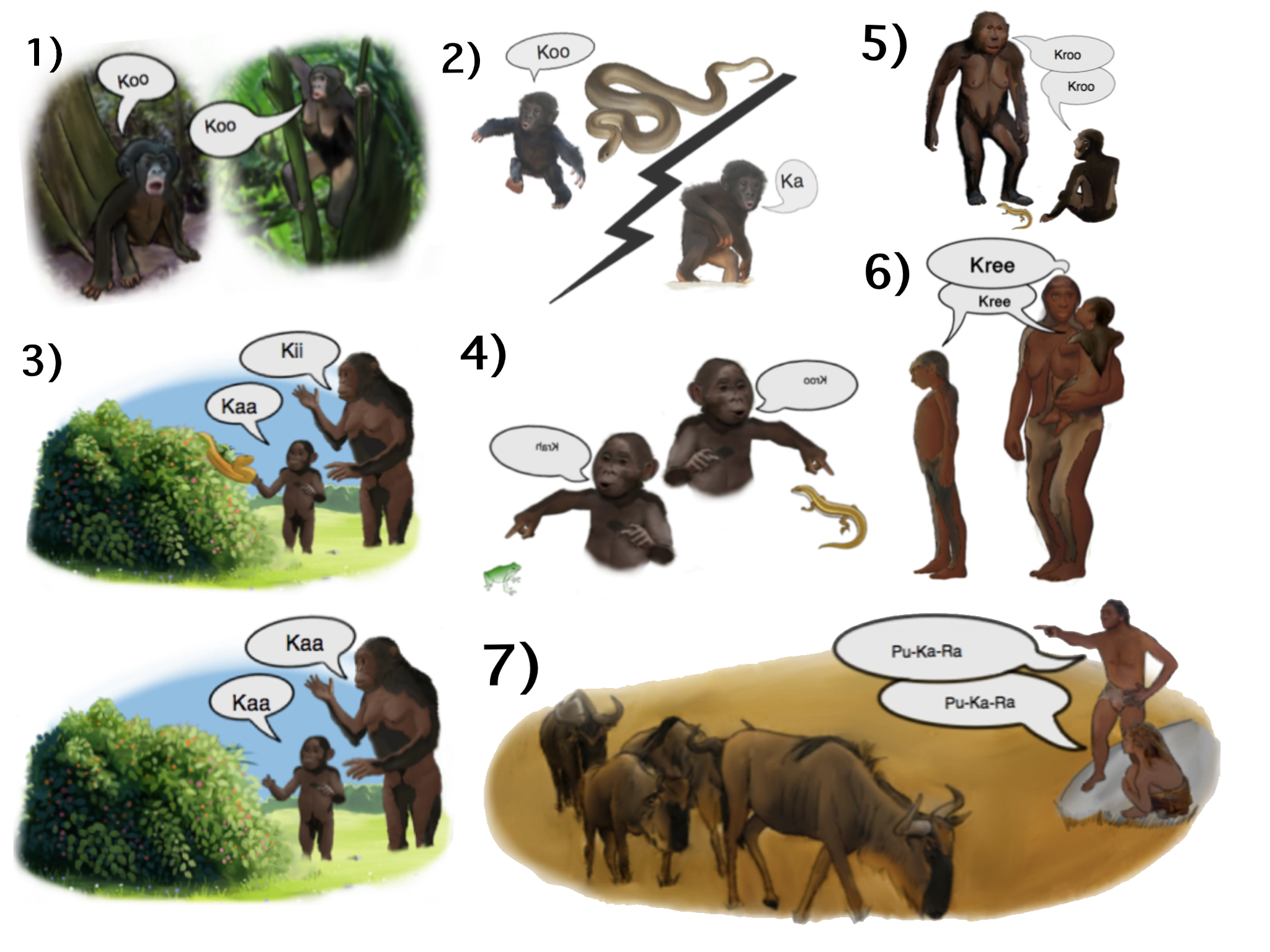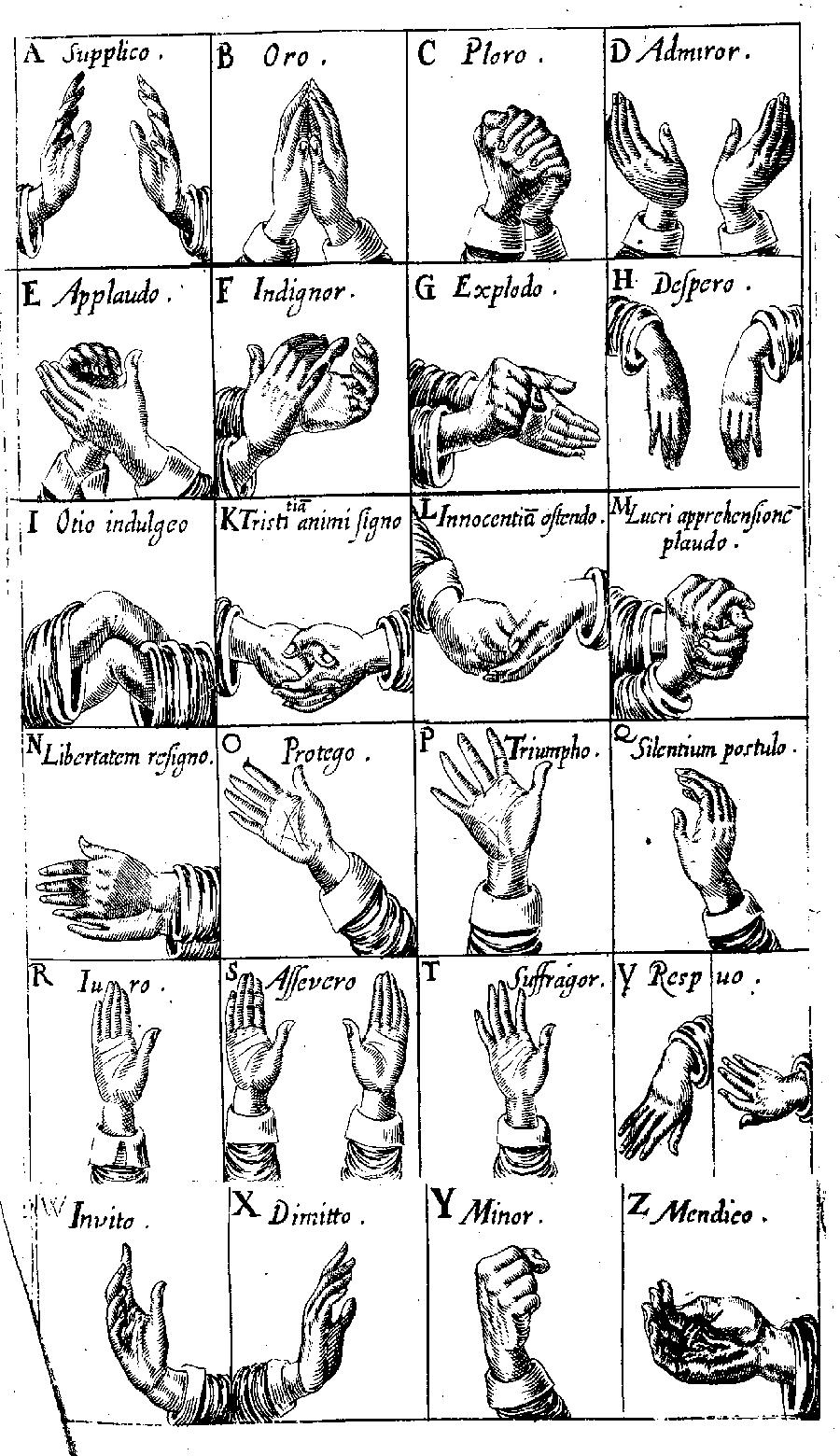|
Gesture
A gesture is a form of nonverbal communication or non-vocal communication in which visible bodily actions communicate particular messages, either in place of, or in conjunction with, speech. Gestures include movement of the hands, face, or other parts of the Human body, body. Gestures differ from physical non-verbal communication that does not communicate specific messages, such as purely Emotional expression, expressive displays, proxemics, or displays of joint attention.Kendon, Adam. (2024) ''Gesture: Visible Action as Utterance''. Cambridge: Cambridge University Press. Gestures allow individuals to communicate a variety of feelings and thoughts, from contempt and hostility to approval and affection, often together with body language in addition to words when they speak. Gesticulation and speech work independently of each other, but join to provide emphasis and meaning. Gesture processing takes place in areas of the brain such as Broca's area, Broca's and Wernicke's areas, wh ... [...More Info...] [...Related Items...] OR: [Wikipedia] [Google] [Baidu] |
Nonverbal Communication
Nonverbal communication is the transmission of messages or signals through a nonverbal platform such as eye contact (oculesics), body language (kinesics), social distance (proxemics), touch (Haptic communication, haptics), voice (prosody (linguistics), prosody and paralanguage), physical environments/appearance, and use of objects. When communicating, nonverbal channels are utilized as means to convey different messages or signals, whereas others interpret these messages. The study of nonverbal communication started in 1872 with the publication of ''The Expression of the Emotions in Man and Animals'' by Charles Darwin. Darwin began to study nonverbal communication as he noticed the interactions between animals such as lions, tigers, dogs etc. and realized they also communicated by gestures and expressions. For the first time, nonverbal communication was studied and its relevance noted. Today, scholars argue that nonverbal communication can convey more meaning than verbal communica ... [...More Info...] [...Related Items...] OR: [Wikipedia] [Google] [Baidu] |
David McNeill
Glenn David McNeill (born 1933 in California, United States) is an American psychologist and writer specializing in scientific research into psycholinguistics and especially the relationship of language to thought, and the gestures that accompany discourse. Life and career David McNeill is a professor of the University of Chicago in Illinois, and a writer. Education McNeill studied for and was awarded a Bachelor of Arts in 1953 and a Doctor of Philosophy in 1962, both in psychology, at the University of California, Berkeley. He went on to study at the Center for Cognitive Studies, Harvard University in 1963. Academic positions held *Harvard University, Research Fellow, Center for Cognitive Studies (1963–1965) *University of Michigan, Assistant to associate professor of psychology (1965–1969) *Harvard University, Visiting associate professor of psychology (1967–1969) *University of Chicago, Professor of Psychology and Linguistics (1969–2001) *Institute for Advanced St ... [...More Info...] [...Related Items...] OR: [Wikipedia] [Google] [Baidu] |
Origin Of Language
The origin of language, its relationship with human evolution, and its consequences have been subjects of study for centuries. Scholars wishing to study the origins of language draw inferences from evidence such as the fossil record, archaeological evidence, and contemporary language diversity. They may also study language acquisition as well as comparisons between human language and systems of animal communication (particularly other primates). Many argue for the close relation between the origins of language and the origins of modern human behavior, but there is little agreement about the facts and implications of this connection. The shortage of direct, empirical evidence has caused many scholars to regard the entire topic as unsuitable for serious study; in 1866, the Linguistic Society of Paris banned any existing or future debates on the subject, a prohibition which remained influential across much of the Western world until the late twentieth century. Various hypotheses ... [...More Info...] [...Related Items...] OR: [Wikipedia] [Google] [Baidu] |
Broca's Area
Broca's area, or the Broca area (, also , ), is a region in the frontal lobe of the dominant Cerebral hemisphere, hemisphere, usually the left, of the Human brain, brain with functions linked to speech production. Language processing in the brain, Language processing has been linked to Broca's area since Pierre Paul Broca reported impairments in two patients. They had lost the ability to speak after injury to the posterior inferior frontal gyrus (pars triangularis) (BA45) of the brain. Since then, the approximate region he identified has become known as Broca's area, and the deficit in language production as Broca's aphasia, also called expressive aphasia. Broca's area is now typically defined in terms of the pars opercularis and pars triangularis of the inferior frontal gyrus, represented in Korbinian Brodmann, Brodmann's Brodmann area, cytoarchitectonic map as Brodmann area 44 and Brodmann area 45 of the dominant hemisphere. Functional magnetic resonance imaging (fMRI) has show ... [...More Info...] [...Related Items...] OR: [Wikipedia] [Google] [Baidu] |
Body Language
Body language is a type of nonverbal communication in which physical behaviors, as opposed to words, are used to express or convey information. Such behavior includes facial expressions, body posture, gestures, eye movement, touch and the use of space. Although body language is an important part of communication, most of it happens without conscious awareness. In social communication, body language often complements verbal communication. Nonverbal communication has a significant impact on doctor-patient relationships, as it affects how open patients are with their doctor. As an unstructured, ungrammatical, and broadly-interpreted form of communication, body language is not a form of language. It differs from sign language, sign languages, which are true languages with complex grammar systems and exhibiting the fundamental properties considered to exist in all languages. Some researchers conclude that nonverbal communication accounts for the majority of information transmitted d ... [...More Info...] [...Related Items...] OR: [Wikipedia] [Google] [Baidu] |
John Bulwer
John Bulwer (baptised 16 May 1606 – buried 16 October 1656) was an English people, English physician and early Baconian method, Baconian natural philosopher who wrote five works exploring the Body and human communication, particularly by gesture. He was the first person in England to propose educating deaf people, the plans for an Academy he outlines in ''Philocophus'' and ''The Dumbe mans academie''. Life John Bulwer was born in London in 1606 and continued to work and live in the city until his death in October 1656 when he was buried in St Giles in the Fields, Westminster. He was the only surviving son of an apothecary named Thomas Bulwer and Marie Evans of St. Albans. On her death in 1638 John Bulwer inherited some property in St Albans from which he derived a small income. Although information about his education is unclear, there is evidence that he was probably educated in Oxford as an unmatriculated student in the 1620s. His known friends had nearly all been educated ... [...More Info...] [...Related Items...] OR: [Wikipedia] [Google] [Baidu] |
Sign Language
Sign languages (also known as signed languages) are languages that use the visual-manual modality to convey meaning, instead of spoken words. Sign languages are expressed through manual articulation in combination with #Non-manual elements, non-manual markers. Sign languages are full-fledged natural languages with their own grammar and lexicon. Sign languages are not universal and are usually not mutual intelligibility, mutually intelligible, although there are similarities among different sign languages. Linguists consider both spoken and signed communication to be types of natural language, meaning that both emerged through an abstract, protracted aging process and evolved over time without meticulous planning. This is supported by the fact that there is substantial overlap between the neural substrates of sign and spoken language processing, despite the obvious differences in modality. Sign language should not be confused with body language, a type of non verbal communicati ... [...More Info...] [...Related Items...] OR: [Wikipedia] [Google] [Baidu] |
Communication
Communication is commonly defined as the transmission of information. Its precise definition is disputed and there are disagreements about whether Intention, unintentional or failed transmissions are included and whether communication not only transmits semantics, meaning but also creates it. Models of communication are simplified overviews of its main components and their interactions. Many models include the idea that a source uses a code, coding system to express information in the form of a message. The message is sent through a Communication channel, channel to a receiver who has to decode it to understand it. The main field of inquiry investigating communication is called communication studies. A common way to classify communication is by whether information is exchanged between humans, members of other species, or non-living entities such as computers. For human communication, a central contrast is between Verbal communication, verbal and non-verbal communication. Verba ... [...More Info...] [...Related Items...] OR: [Wikipedia] [Google] [Baidu] |
Andrea De Jorio
Andrea De Jorio (1769–1851) was an Italian antiquarian who is remembered today among ethnographers as the first ethnographer of body language, in his work ''La mimica degli antichi investigata nel gestire napoletano'', 1832 ("The mime of the Ancients investigated through Neapolitan gesture"). The work has been mined, refined and criticized. Born on the island of Procida in the Gulf of Naples, De Jorio became a Canon at the Cathedral of Naples, a respected archaeologist under the pre-modern conditions of his times, and a curator at the predecessor to the Museo Archeologico Nazionale, Naples. He wrote very extensively about the then-recent excavations of classical antiquity near Naples, such as Pompeii, Herculaneum, and Cumae. His recognition in the frescos of Pompeii and Herculaneum provided him with his insight, that the gestures depicted were familiar to him in the streets of modern Naples Naples ( ; ; ) is the Regions of Italy, regional capital of Campania and th ... [...More Info...] [...Related Items...] OR: [Wikipedia] [Google] [Baidu] |
Joint Attention
Joint attention or shared attention is the shared focus of two individuals on an object. It is achieved when one individual alerts another to an object by means of eye-gazing, pointing or other verbal or non-verbal indications. An individual gazes at another individual, points to an object and then returns their gaze to the individual. Scaife and Bruner were the first researchers to present a cross-sectional description of children's ability to follow eye gaze in 1975. They found that most eight- to ten-month-old children followed a line of regard, and that all 11- to 14-month-old children did so. This early research showed it was possible for an adult to bring certain objects in the environment to an infant's attention using eye gaze. Subsequent research demonstrates that two important skills in joint attention are following eye gaze and identifying intention. The ability to share gaze with another individual is an important skill in establishing reference. The ability to iden ... [...More Info...] [...Related Items...] OR: [Wikipedia] [Google] [Baidu] |
Hand
A hand is a prehensile, multi-fingered appendage located at the end of the forearm or forelimb of primates such as humans, chimpanzees, monkeys, and lemurs. A few other vertebrates such as the Koala#Characteristics, koala (which has two thumb#Opposition and apposition, opposable thumbs on each "hand" and fingerprints extremely similar to human fingerprints) are often described as having "hands" instead of paws on their front limbs. The raccoon is usually described as having "hands" though opposable thumbs are lacking. Some evolutionary anatomists use the term ''hand'' to refer to the appendage of digits on the forelimb more generally—for example, in the context of whether the three Digit (anatomy), digits of the bird hand involved the same Homology (biology), homologous loss of two digits as in the dinosaur hand. The human hand usually has five digits: Finger numbering#Four-finger system, four fingers plus one thumb; however, these are often referred to collectively as Finger ... [...More Info...] [...Related Items...] OR: [Wikipedia] [Google] [Baidu] |






